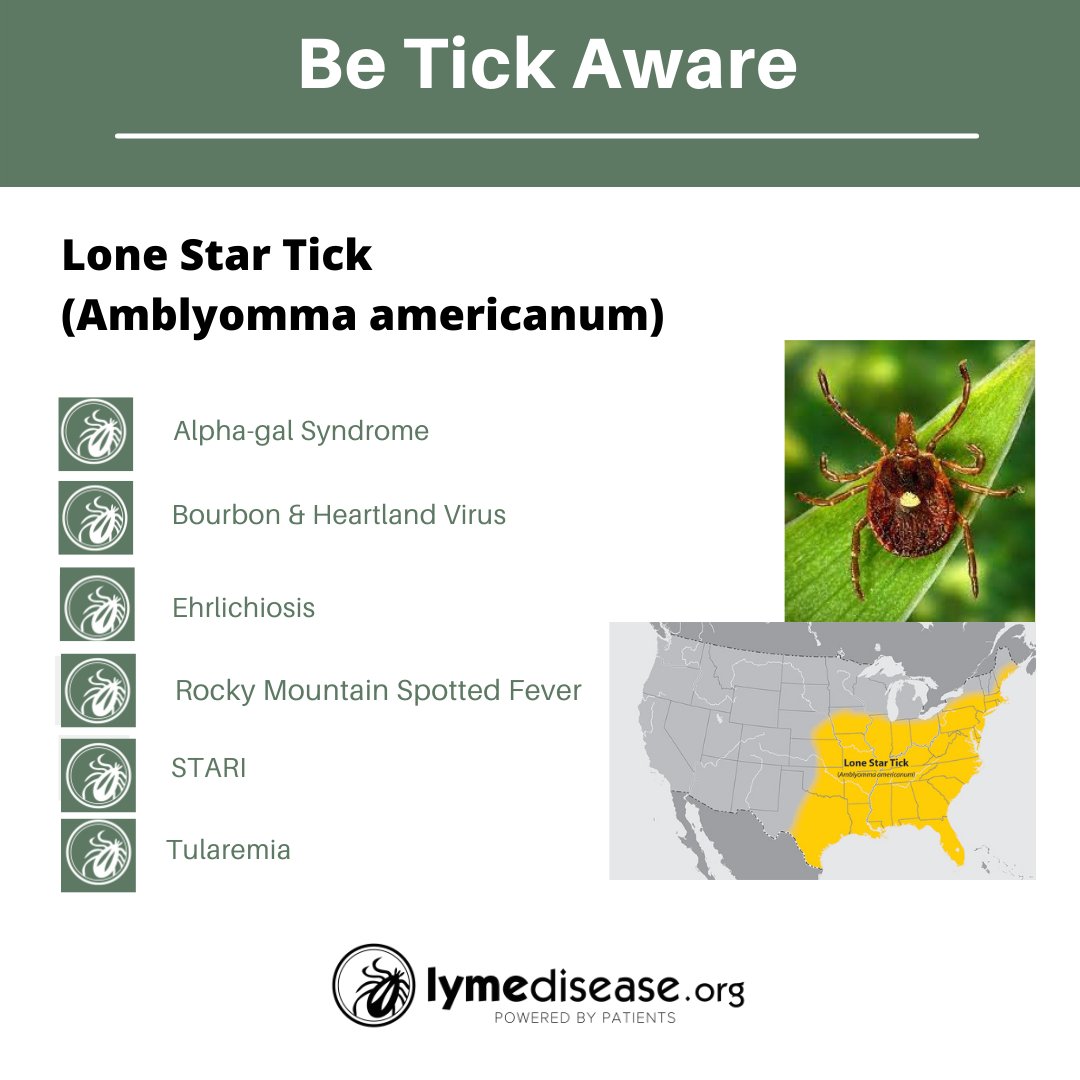
The lone star tick (Amblyomma americanum) has been rapidly expanding its range, from the Southern United States into the Northeast and Midwest. This tick is a major vector of several viral, bacterial, and protozoan pathogens affecting humans & animals.🧵 lymedisease.org/lyme-sci-super…
A recent crowdsourced science project has documented the largest increase of the lone star tick in decades. Researchers @TickSpotters documented new tick encounters in over 300 counties—including six new counties in western states—where these ticks had not been documented before. 

“The causative drivers of these upturns are complex, but have a lot to do with increased host availability, warming temperatures, and moisture availability,” says researcher Heather L Kopsco, PhD @HLK110
Source for our map (Kopsco et al, 2021) academic.oup.com/jme/article/58…
Source for our map (Kopsco et al, 2021) academic.oup.com/jme/article/58…

Female lone star #ticks are identifiable by a single silvery-white spot on the center of their back (scutum.) The male lone star tick is slightly smaller, with varied white streaks or spots around the margins of its body. 

The lone star tick is known to transmit several pathogens causing illness in humans.
People bitten by a lone star tick may also develop alpha-gal syndrome—a severe allergy to meat and meat-related products.
Learn more about alpha-gal syndrome (AGS): lymedisease.org/alpha-gal-synd…
People bitten by a lone star tick may also develop alpha-gal syndrome—a severe allergy to meat and meat-related products.
Learn more about alpha-gal syndrome (AGS): lymedisease.org/alpha-gal-synd…

Common symptoms of alpha-gal syndrome (AGS). Onset of these symptoms may take weeks to months (average 4-6 weeks) after the bite of the lone star tick. #allergies 

Bourbon virus is one of two known tick-borne viruses carried by the lone star tick. #Ticks can transmit viruses in as little as 15 minutes.
Learn more about tick-borne viruses. lymedisease.org/lyme-sci-tick-…
Learn more about tick-borne viruses. lymedisease.org/lyme-sci-tick-…

Little is known about Bourbon virus, first discovered in 2015. Symptoms are flu-like, and the tests for Bourbon are not readily available, so it's likely going under-detected and under-diagnosed. 

While the majority of Americans have heard of Lyme disease, fewer than 2% have any knowledge of #ehrlichiosis, another pathogen carried by the lone star tick.
Learn more about ehrlichiosis: lymedisease.org/ehrlichiosis-t…
Learn more about ehrlichiosis: lymedisease.org/ehrlichiosis-t…

While some cases of #ehrlichiosis are mild, the disease can be severe or fatal if not treated correctly. Because Ehrlichia infect white blood cells, and mitochondria (the powerhouse of the human cell) the consequences of untreated infection may have long-lasting effects. 

Heartland virus, another virus carried by the lone star tick, "is an emerging infectious disease that is not well understood,” says Gonzalo Vazquez-Prokopec @prokopeclab
Learn more about #HeartlandVirus lymedisease.org/heartland-lone…
Learn more about #HeartlandVirus lymedisease.org/heartland-lone…

Most people infected with Heartland virus experience fever, fatigue, decreased appetite, headache, nausea, diarrhea, and muscle or joint pain. Many require hospitalization. #ticks 

Occasionally, the lone star tick has been known to carry Rickettsia rickettsii, also known as Rocky Mountain spotted fever (RMSF), one of the deadliest tick-borne diseases in the U.S.
Learn more about RMSF: lymedisease.org/lyme-sci-ricke…
Learn more about RMSF: lymedisease.org/lyme-sci-ricke…

Initial symptoms of #RMSF typically include high fever, severe headache, abdominal pain (with or without vomiting), and muscle pain. It often—though not always—includes a spotted rash that begins at the wrist and/or ankles, and spreads outward from there. 

In the South, a Lyme-like disease called STARI (Southern Tick-Associated Rash Illness) is thought to be transmitted by the lone star tick (Amblyomma americanum)
Learn more about Edwin "Ed" Masters, the MD who first described STARI: lymedisease.org/141/
Learn more about Edwin "Ed" Masters, the MD who first described STARI: lymedisease.org/141/

#Tularemia is caused by the bacterium Francisella tularensis. People can become infected by both deer fly and tick bites (including lone star), skin contact w/ infected animals, drinking contaminated water, or inhaling contaminated aerosols or agricultural & landscaping dust. 

The signs and symptoms of tularemia vary depending on how the bacteria enter the body. Illness ranges from mild to life-threatening. All forms are accompanied by fever, which can be as high as 104 °F.
Learn more about Tularemia: cdc.gov/tularemia/inde…
Learn more about Tularemia: cdc.gov/tularemia/inde…

The range of the lone star tick has increased dramatically over the past 30 years. This tick is known to transmit 6 pathogens, trigger alpha-gal syndrome & carry a toxin that can cause a progressive paralysis (which is reversed when the tick is removed.) #BeTickAware /end 

• • •
Missing some Tweet in this thread? You can try to
force a refresh



